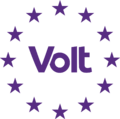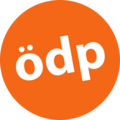List of political parties in Germany facts for kids
Germany is a country where many different political parties exist. This is called a plural multi-party system. Imagine a big team where many smaller teams work together! In Germany, these parties work together to form the government.
Historically, the biggest parties have been the Christian Democratic Union (CDU) and its sister party, the Christian Social Union (CSU), along with the Social Democratic Party of Germany (SPD). Other important parties include the Free Democratic Party (FDP), Alliance 90/The Greens, The Left, and more recently, the Alternative for Germany (AfD).
Often, the German government is formed by a coalition, which means two or more parties agree to work together. For example, the CDU/CSU might team up with the FDP, or the SPD might team up with the FDP or the Greens. Sometimes, the two largest parties, the CDU/CSU and SPD, form a "grand coalition" to govern together.
Parties in Germany are often known by their special colors. The Social Democratic Party is red, the Greens are green, the Free Democratic Party is yellow, The Left is purple (or red), the AfD is light blue, and the CDU and CSU are black and blue.
Contents
Germany's Main Political Parties
Germany has many political parties, but some are more important because they have members in the Bundestag (Germany's parliament) or the European Parliament.
Parties in the German Parliament (Bundestag)
These are the main parties that help make laws for Germany.
| Party | Abbreviation | Main Idea | Leader(s) | Members | ||
|---|---|---|---|---|---|---|
| Christian Democratic Union of Germany | CDU | Christian ideas, traditional values | Friedrich Merz | 363,100 | ||
| Christian Social Union in Bavaria | CSU | Christian ideas, traditional values (mostly in Bavaria) | Markus Söder | 131,000 | ||
| Alternative for Germany | AfD | Focus on national interests, less European cooperation | Tino Chrupalla, Alice Weidel |
46,881 | ||
| Social Democratic Party of Germany | SPD | Fairness for everyone, social support | Lars Klingbeil, Saskia Esken |
365,190 | ||
| Alliance 90/The Greens | GRÜNE | Protecting the environment, social justice | Felix Banaszak, Franziska Brantner |
166,000 | ||
| The Left | LINKE | More equality, helping the poor | Jan van Aken, Ines Schwerdtner |
102,412 | ||
| South Schleswig Voters' Association | SSW | Supports Danish and Frisian minorities | Christian Dirschauer | 3,216 | ||
Parties in the European Parliament
These parties have members who represent Germany in the European Parliament, which makes laws for all of Europe.
| Party | Abbreviation | Main Idea | Leader(s) | Members | ||
|---|---|---|---|---|---|---|
| Sahra Wagenknecht Alliance | BSW | Focus on social justice and traditional values | Sahra Wagenknecht, Amira Mohamed Ali |
1,200 | ||
| Free Democratic Party | FDP | Freedom for individuals, strong economy | - | 70,000 | ||
| Free Voters | FW | Local issues, less government control | Hubert Aiwanger | 6,225 | ||
| Volt Germany | Volt | Stronger European cooperation | Lara Neumann, Tim Marton | 4,000 | ||
| Die PARTEI | Die PARTEI | Political humor and satire | Martin Sonneborn | 51,078 | ||
| Ecological Democratic Party | ÖDP | Protecting the environment, traditional values | Christian Rechholz | 8,035 | ||
| Party of Progress | Modern ideas, European cooperation | Lukas Sieper | 302 | |||
| Family Party of Germany | Familie | Supporting families and Christian values | Helmut Geuking | 705 | ||
| Human Environment Animal Protection Party | Tierschutzpartei | Animal rights, environmental protection | Aida Spiegeler Castaneda Marcel Krohn Robert Gabel |
2,400 | ||
Other Smaller Parties
Germany has many other smaller parties that might not be in the main parliament or European Parliament, but they still work to represent different ideas and groups of people. Some of these parties focus on specific issues, like animal rights, direct democracy, or regional interests.
Germany's Political History
Germany's political landscape has changed a lot over time. After World War II, Germany was divided into West and East Germany, and each had its own political parties. When Germany became one country again in 1990, many parties from East Germany joined with parties in West Germany.
Parties from the Past
Many political parties have existed in Germany's history that are no longer active today. Some of these parties were important during different periods, like the Weimar Republic (before World War II) or when Germany was divided. They represented different ideas and helped shape the country's past.
Images for kids
See also
 In Spanish: Partidos políticos de Alemania para niños
In Spanish: Partidos políticos de Alemania para niños
- Lists of political parties
- History of Germany since 1945













